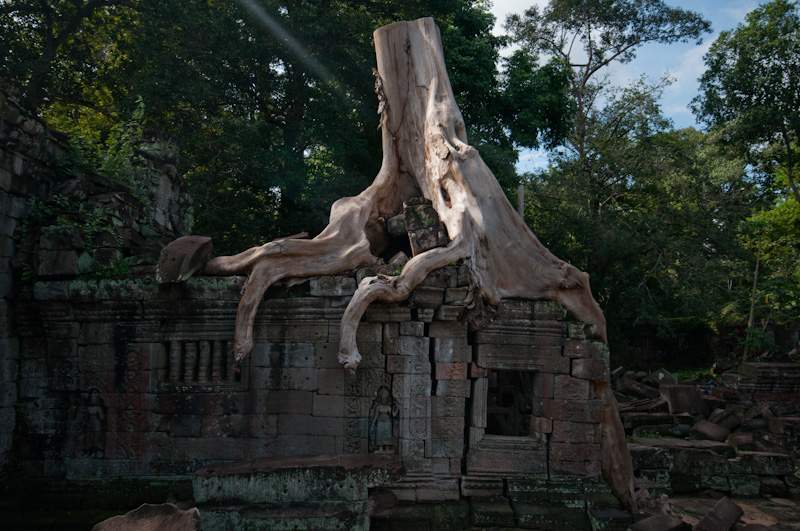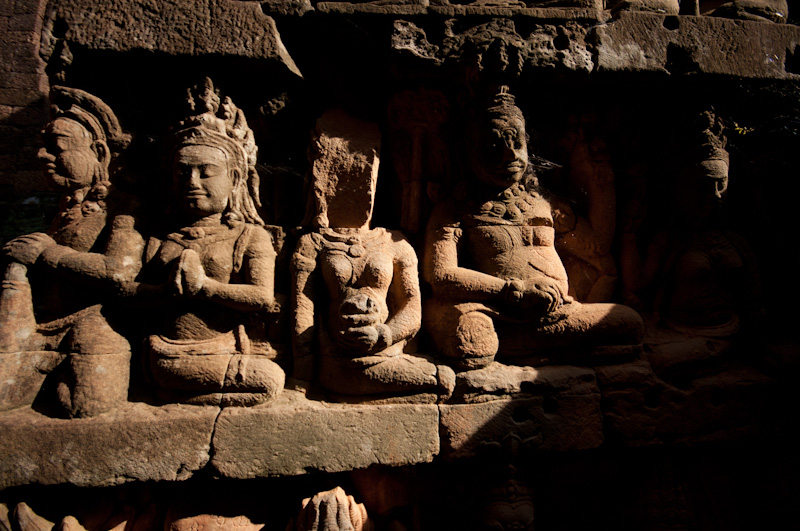Ankor Wat and the Khmer Empire

Prah Khan temple, Angkor Wat
The history of Cambodia dates back to 2000 years ago. The former Kingdom of Funan grew in power over the years to become the Khmer Empire in the ninth century. Many problems plagued the empire, but still it had been consistently gaining the importance in the region. It is also notable that the royal family lived to see almost forty successive kings. So powerful and historically rich civilization could have never be simply forgotten. Well, apparently and ironically it has been forgotten! Until the second half of the nineteenth century the great complex of Angkor Wat was hidden under cover of dense jungle, thus invisible for the western world.
The site has over a hundred temples spread around an enormously vast area. While waking up in the dark at 4:30 in the morning to reach the temple site half an hour later is a good idea, then watching the sunrise through the clouds together with hundreds of tourists diminishing the overall impression is rather not as enjoyable. Is it the only way to see Angkor Wat, just like anybody else?
We avoid the mob quickly jumping inside the Angkor. Then we swiftly move through the chambers and enjoy the fact that we are here all alone. The morning light is also great for taking pictures.

The early morning sun cast warm light on the hand-carved facade
We visit the entire complex riding old, out-of-shape bicycles, which we have rented the day before. Untill 7.30 in the morning the temperature is fine, at around 9 o’clock it turns a bit too hot and from ten onwards the heat is unbearable.
The whole area occupied by temples is gigantic. Each of the historic venues we visit has a touch of magic, mystery, also is inspiring curiosity and generally fits well together with other monuments, still it also has a bit of a distinctive character.
The temples of Ta Phrom and Ta Som attract my attention most – these are one of the many sites where massive trees cover and interact with the building structure in a spectacular way.
Wandering along the paths cut through the jungle we reach some hidden temples, noticeably less visited and less adapted to the public. One of such places is a temple having extremely steep stairs, whose name escapes me. I do not believe that anywhere in Europe that kind of place would be approved for public use, mainly because of non-existent safety and security measures. Certainly, I few careless people must have died here. The stairs are so steep and narrow that it feels more like climbing a ladder without the possibility of placing the entire foot on a rung. Climbing the ocassionaly brittle, loose or missing parts, sometimes even wet and slippery is almost a challenge. On the other hand, the view from the top of the sun setting over the jungle is a fair reward for the increased risk taken.
The number of kilometers we passed during the day demonstrates the extent of Angkor Wat. Including a small break for a Khmer dinner and a way to and back to Siem Reap, during one day of sightseening we made more than 70 kilometers on our bikes.
Khmer food

In the back of restaurant kitchen, Siem Reap
What else can you do in Siem Reap, the base city for exploring Angkor Wat? The famous Pub Street is ready to entertain tourists round-the-clock. This is an area of about two square kilometers, which has arguably the highest density of pubs and restaurants throughout Asia. The nightmarket serving Khmer food becomes our inspiration for signng up for a cooking course.
Temple Bar on Pub Street runs such courses daily. I do not know whether this is my lucky day or maybe someone just realized that the culinary skills are not my strongest asset. The point is I am the only one who got a personal cooking instructor. In this way I get to know a friendly 28-year-old Nary, who will introduce me to the secrets of local cuisine.
We start cooking and soon it completely absorbs us. It’s really engaging and inspiring activity. Especially knowing real-time how to follow the recipe and reach the goal.
A few hours pass.
Each of us has prepared three dishes that are part of the traditional Khmer cuisine. The food I prepared includes fresh spring rolls, chicken curry and dessert made of legume seeds. All together we have as many as nine dishes on our table. Right now the long-awaited part of the course is about to start.
Having eaten so much is more than enough for the rest of the day. Where else in the world you can learn how to cook, eat delicious food to your heart’s content, discover a lot about an interesting culture, also get a recipe booklet and a free souvenir t-shirt for as little as ten dollars?
October 2010
[eazyest_folder folder=”sea/kh-main”]